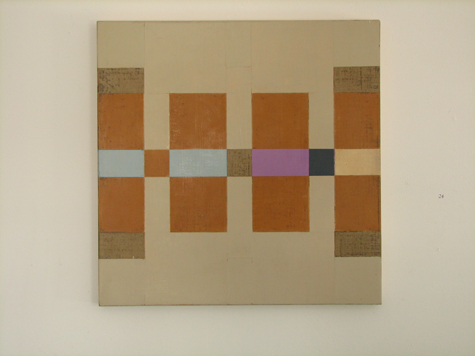
SPEAKING IN TONGUES “Untitled (4241),” acrylic, canvas, linen, wood, by Duane Paluska.
|
The task of abstraction is never complete. At the very least, there will always be less stuff to represent.
Though unifying themes and concepts may be absent, this midsummer show at the June Fitzpatrick catches a convergence of artists at a crossroads of unique material processes. At most only hinting at representation or expression, the works of these seven artists reflect both compositional maturity and ritualistic technique.
If they weren't well past budget, Duane Paluska's sculptures could double as props in Samuel Beckett plays. "Rex," a gorgeous and vaguely canine structure of painted wood, blends an obscured utility with obedient, enlightened craftsmanship. While it's unclear the function "Rex" has, say, in the home, its presence evokes an existential concern not at all ironic or whimsical. Elsewhere, Paluska's acrylic patterns on canvas-mounted wood display the precision of an expert textilist. "Untitled (4241)" collects autumnal squares and rectangles in a symmetric series, yielding — as a verse and chorus would — to a purple and black bridge. Paluska's work speaks the language of the abstract in a wholly recognizable tongue.
Eight ruminations by MECA graduate Noa Warren explore the pliability of visual perception. His highly detailed square panels display amorphous shapes and swelling, illusory fields. As completed objects, Warren's paintings still breathe with the animation of his process: born from a template of graph paper crumpled out of uniformity, he layers acrylic paint on thin linen to plot the contorted assemblage of the graph tablet. The result is a spectral swatch, an unsettling investigation of actual and artificial dimensions.
From a distance, Larry Hayden's "Nine Foot Passage" looks like a response to Kate Beck's untitled masterwork from Paluska's ICON Gallery in past May (see "More Than Black and White," by Nicholas Schroeder, May 21). In both (Beck's is not shown here), tightly bound vertical lines play with emptiness and density without committing to a definitive pattern. Though both operate within similar frames and grayscales, the six layers of Sumi ink add a voluminous fatness to Hayden's swells; the lines seem to tunnel more than in the clean graphite renderings of Beck's work. This process represents a dramatic departure from his usual pursuits of vivid formal and figure paintings — in fact, so inspired by Indian ink is he that Hayden has continued his composition ad infinitum: "Nine Foot Passage" is merely a snippet. And though it may be terra incognita for Hayden, the field of abstract vertical lines is not an exclusive domain. A full expression of this study, already touted as the "largest drawing in Maine," will cover the walls of the gallery next month.
Joanne Mattera's four small tiles represent another departure. Employing familiar interactions of vivid color on a grid, Mattera's focus on translucence and opacity is upheld here in gouache rather than thick pigmented wax. Greg Parker's large gesso panels are thickly layered with rich patterns of oil paint. The depth of his coloration is particularly astounding in "Untitled 2010.124," where a series of seven blue horizontal lines are repeated over a dense green backdrop. Lynda Litchfield's encaustic panels benefit from their faint traces of nostalgia and sentimentality. Her "Diagram D (echo)" bisects attention between a dark landscape and the promised volume of a simple line drawing in the foreground, while "Diagram C (sounding)" attempts to harmonize two chilly hues.